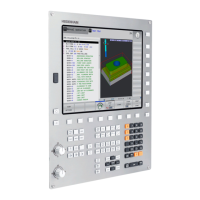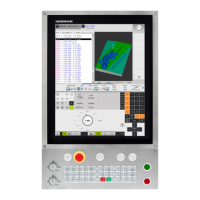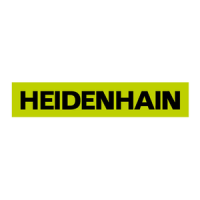Do you have a question about the HEIDENHAIN TNC 370 and is the answer not in the manual?
Overview of the TNC 370 control, its operating panel, programming capabilities, and compatibility.
Covers NC basics, part programs, reference systems, coordinate systems, and tool movements.
Details the procedure for switching on the TNC, including initial dialogs and traversing reference points.
Explains plan view, projection in three planes, 3D view, and status display information.
Describes generating and manipulating graphics during the programming process.
Covers program management, including creating, protecting, copying, renaming, and erasing programs.
Instructions for traversing axes using direction keys, electronic handwheel, and manual data input.
Details on entering and changing spindle speed, feed rate, and miscellaneous functions.
Procedure for setting the workpiece datum in the tool axis and working plane.
Explains how to perform test runs to check programs for geometrical incompatibility, missing data, or impossible jumps.
Details on running programs continuously or block by block, including interruption and resumption.
Method for executing long programs by transferring them block by block from an external storage device.
Instructions on how to ignore blocks programmed with a '/' sign during program or test runs.
Procedure for optionally interrupting a program run using the M01 function.
Covers program layout, plain language dialog, editing functions, and inserting/erasing blocks and words.
Details on determining tool data, entering it into programs or tables, calling tool data, and tool changes.
Explains the effect of tool compensation for length (L) and radius (R) on machining paths.
Steps for creating new part programs and defining the rectangular workpiece blank using MIN and MAX points.
Instructions for entering feed rate (F) and spindle speed (S) values within part programs.
How to use M functions for spindle control, coolant, and program stops.
Using the 'actual position capture' feature to enter coordinates directly into a part program.
How to mark blocks with a '/' sign to be ignored during program or test runs.
Adding comments to part programs using semicolons for clarity and documentation.
Basic principles of tool movement programming, including path functions and FK free contour programming.
Methods for smooth approach and departure from contours using tangential arcs (RND function).
Overview of path functions for programming straight lines, circular arcs, and helical paths.
Programming contour elements like straight lines, chamfers, circles, and arcs using Cartesian coordinates.
Programming contour elements, including straight lines and circular paths, using polar coordinates.
Using FK for programming contour elements with unconventional coordinate data and auxiliary points.
How M functions like M90, M97, M98, M91/M92, M94, M126, M109/M110 affect contouring and coordinate transformations.
Performing positioning operations, such as correcting workpiece misalignment, using manual data input.
Principle, operating limits, and programming of subprograms using labels and CALL LBL commands.
Principle, programming notes, and calling program sections for repetition using labels and REP command.
Using entire programs as subprograms and their operating limits.
Understanding nesting depth for subprograms and program section repeats.
Using Q parameters with the FNO: ASSIGN function to program families of parts with variable dimensions.
Utilizing mathematical functions like ASSIGN, ADDITION, SUBTRACTION, MULTIPLICATION, DIVISION, and SQUARE ROOT with Q parameters.
Overview of trigonometric functions (sine, cosine, tangent, angle calculation) for programming complex shapes.
Implementing conditional logic and jumps (IF EQUAL, IF NOT EQUAL, IF GREATER THAN, IF LESS THAN) using Q parameters.
How to call, check, and modify Q parameter values in the Q parameter table.
Displaying error messages using FN14: ERROR and outputting Q parameters via FN15: PRINT.
Using FN18: SYSREAD to read system data and store it in Q parameters.
Practical examples demonstrating programming with Q parameters for rectangular pockets, bolt hole circles, and ellipses.
Introduction to cycles, their grouping, and how they are programmed and called.
Details on PECKING, DRILLING, REAMING, BORING, UNIVERSAL DRILLING, TAPPING, and RIGID TAPPING cycles.
Cycles for milling rectangular and circular pockets, studs, and slots, including roughing and finishing operations.
Cycles for creating CIRCULAR PATTERN (220) and LINEAR PATTERN (221) hole arrangements.
Subcontour List (SL) cycles for complex contour machining, including overlapping pockets and islands.
Cycles for machining flat, oblique, and twisted surfaces using MULTIPASS MILLING and RULED SURFACE.
Cycles for DATUM SHIFT, MIRROR IMAGE, ROTATION, and SCALING FACTOR to modify contour positions and sizes.
Cycles for DWELL TIME, PROGRAM CALL, and ORIENTED SPINDLE STOP for specialized operations.
Overview of HEIDENHAIN touch probe systems (TS 120, TS 630, TT 120) and their typical applications.
Using touch probe functions for compensating workpiece misalignment, datum setting, and calibration.
Procedures for measuring positions, workpiece dimensions, angles, and using the probe during program run.
Scanning 3D surfaces using MEANDER (line-by-line) and CONTOUR LINES cycles to create digital data.
Converting digitized data into NC part programs and executing them.
Automatic tool measurement cycles (CALIBRATE, TOOL LENGTH, TOOL RADIUS) using the TT 120 probe.
Overview of blockwise transfer, loading programs into TNC, transferring files to external devices, and printing.
Details on RS-232-C/V.24 interface pin layouts and connecting cables for HEIDENHAIN and non-HEIDENHAIN devices.
Steps for preparing HEIDENHAIN floppy disk units and non-HEIDENHAIN devices for data transfer.
Procedure for selecting and exiting MOD functions like user parameters and traverse limits.
Explanation of machine parameters assigned by the tool builder for specific functions.
Choosing between HEIDENHAIN and ISO programming formats, and MM or INCH units for coordinates.
Defining software limits for axis traverse to prevent collisions or protect fixtures.
Configuring the RS-232-C interface and baud rate for data transfer with external devices.
Customizing the status display to show nominal, actual, servo lag, reference, or distance remaining positions.
List of code numbers required to access functions like erase/edit protection and user parameters.
Displaying NC and PLC software version numbers and the amount of free memory.
Using the HELP function as a programming directory for an overview of TNC functions and soft key structures.
Machine parameters affecting TNC behavior, including dialog language, interface, speeds, and sequence.
A comprehensive list of M functions with their effects, effective block timing, and page references.
Details on Q parameters assigned by the TNC, including values from PLC, tool/spindle data, and status.
Overview of TNC features, technical specifications, and available accessories like floppy disk units and touch probes.
Lists and explains common TNC error messages encountered during programming, test run, program run, and digitizing.
| Number of Axes | Up to 5 axes |
|---|---|
| Interfaces | Ethernet, USB, RS-232 |
| Tool Management | Yes |
| Spindle Control | Yes |
| Cycle Support | Yes |
| Graphic Simulation | Yes |
| Control Type | CNC |
| Programming Language | HEIDENHAIN conversational programming |
| Operating Modes | Manual, Automatic, Teach-in |
| Supported File Formats | HEIDENHAIN format |
| Operating Temperature | 0°C to 45°C |
| Storage Temperature | -20°C to 70°C |
| Relative Humidity | Up to 90% non-condensing |
| Protection Class | IP 54 |











